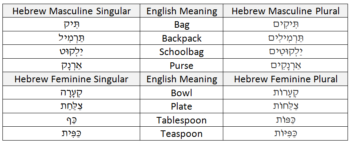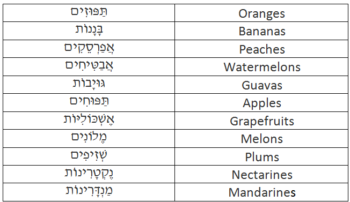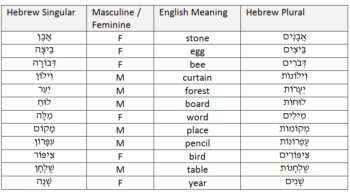Hebrew Plural Nouns Posted by Ayana on Sep 21, 2020 in Grammar
Hebrew nouns can be either singular or plural in number. They are made plural by adding a one-syllable suffix to the end of the singular noun. There are two different plural suffixes, one for each grammatical gender.
All Hebrew nouns are either masculine or feminine. The noun gender affects most of the words in the sentence. The predicate is conjugated according to the gender of the subject; Adjectives are conjugated according to the gender of the noun they are describing; plural is formed according to the singular gender. Grammatical gender in Hebrew is extremely important, and we have already discussed it in our blog.
Most of the Hebrew feminine nouns end with the letter ה or the letter ת. However, masculine nouns end with a variety of consonants. Their plural suffix act accordingly:
Masculine plural nouns usually end in Xיׅם (pronounced as Xim).
Feminine plural nouns usually end in וֺתX (pronounced as Xot).

Let’s check out for example the pronouns יֶלֶד and יַלְדָּה. The masculine pronoun יֶלֶד means a boy, and is pronounced as ye-led. When referring to two or more boys, the pronoun is conjugated to its plural form יְלָדׅים, by adding the masculine plural suffix. This suffix is a closed syllable ים vowelized with hiriq, that changes the pronoun to ye-la-dim. The feminine pronoun יַלְדָּה means a girl, and pronounced as yal-da. When referring to two or more girls, the pronoun is conjugated to its plural form יְלָדוֺת, by adding the feminine plural suffix. The feminine suffix is also a closed syllable – ות that vowelized with holam, and changes the pronoun to ye-la-dot.
More vocabulary of both gender, for example:

Now let’s practice: in the next list composed of plural nouns, all are fruits. Can you figure out which fruit is masculine and which fruit is feminine?

But, every rule has its exceptions (לְכָל כְּלָל יֵשׁ יוֹצֵא מִן הַכְּלָל). Some nouns get the opposite gender’s ending in the plural form. The fruit תְּאֵנָה (fig), for example, is feminine. Its plural, though, ends with the masculine plural suffix – תְּאֵנׅים. The word fruit itself (פְּרִי) is masculine, but its plural ends with the feminine plural suffix – פֵּרוֹת. Unfortunately, there’s no rule to help you figure out which are the exceptions to the rule. You will have to memorize them. Several of them appear, for example, in alphabetical order in the chart below. In future posts, I will add plural forms in the vocabulary list, as well.

The Academy of the Hebrew Language counts more than 180 exceptions. The Academy explains this long list of exceptions by the fact that the two plural suffix are originated in the Biblical Hebrew, but were distinguished to each grammatical gender only centuries later. New words took a plural form according to their gender, but old words haven’t change, of course, and become an exception. You can watch the full list of exceptions of masculine nouns here; and the full list of exceptions of feminine nouns here.
Learning a language is not easy, but always remember – practice makes perfect. Try your best to practice Hebrew every day. Don’t end the day without reading a short paragraph, singing a song, or writing down several sentences. A fluent Hebrew speaker was once a beginner who didn’t give up. So, as I like to say –
Keep Calm and Learn Hebrew!

Build vocabulary, practice pronunciation, and more with Transparent Language Online. Available anytime, anywhere, on any device.





Comments:
frbn:
Hi,
every article is מצוין and מענין.
תודה רבה.
But in
“Masculine plural nouns usually end in Xיׅם (pronounced as Xim).” is a mistake. It should be
יםX